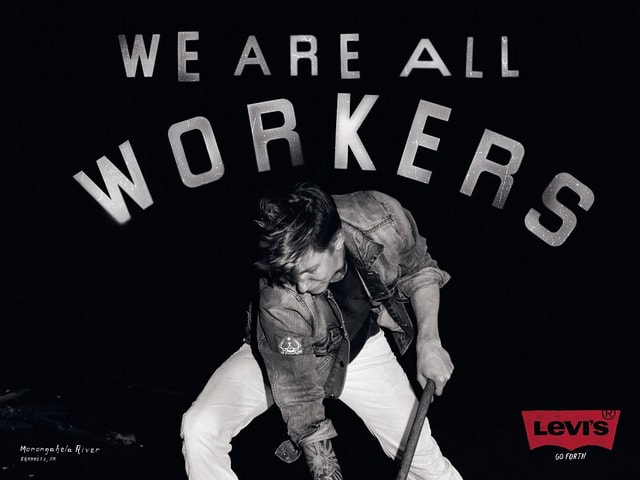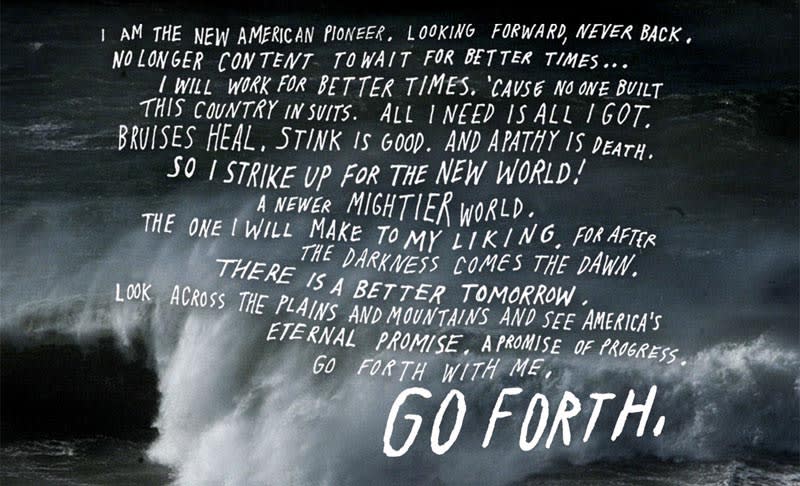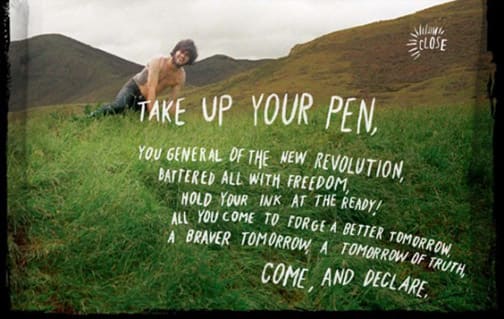Levis Channels American Nostalgia While Off Shoring Production. But they do it beautifully.
This advertising campaign from Levis has been following me around for the last few weeks. Produced by Wieden + Kennedy, the nostalgic Americana advertising campaign is entering it’s second year. The campaign grew to include a segment focused on Braddock Pennsylvania. Braddock is the kind of middle American town that has suffered greatly in the current economic climate, but also struggled greatly with the post industrial turn of the American economy since the mid 80s. The campaign has caused quite the uproar in both the ad and social justice communities. It seems they both hate it, but for different reasons.
I want to get into this a bit, if only to help clarify my own thinking about it. I’m not actually an advertising guy anymore. Though early in my career I did a lot of design for retail campaigns and branding work, the last few years I’ve been primarily focused on UI & UX. Far less on advertising in the traditional sense (traditional sense meaning product/service presentation and consumption – not print vs web). Even though I’m no longer neck deep in the sordid world of advertising, I find every so often an ad campaign comes around that transcends the noise and reaches for something different.
The original Levis Go Forth Ad & The Braddock Ad
The Straight Up Visuals
If you haven’t yet – watch the videos. It takes like 3 minutes, they’re right up there for you. Done? Ok, read on. I stare at, create, dissect, and absorb images and text all day long. So does most everybody, though maybe not so consciously. My gut response to these ads – fucking beautiful. In the barrage of cgi-d motiongraphics laden, dynamic typography, motion blur, augmented reality, witty, glib, I’m a pc hipster irony bullshit that we absorb everyday – the ads are refreshingly simple and straightforward. There’s a criticism floating around the web that their honesty is too honest. Because they lack a postmodern manipulative cleverness – they in fact are uber postmodernly manipulative. To that I say – pull your head out of your ass. That kind of meta analysis is about as useful and interesting as a wet sock. If you want to say – “yeah, but this isn’t going to sell jeans because there isn’t a famous sports person wearing the pants and that’s how you actually sell shit” then fine – make your argument. I won’t necessarily agree with you, but at least it’s grounded in reality and not in sophomore year crit theory class.
The Messaging
Now to use that sophmore crit theory class analysis. I grew up in an upper middle class suburban home during the 90s. It doesn’t take advanced freudian analysis to guess where my personal fetishization of the handmade come from. I’ll acknowledge that I’m predisposed to like this particular message. One of my hobbies is appreciating hand made and artisanal stuff. I can’t always afford it – but I love to look at it. Whether it’s handmade, clothing, furniture, prints, motorcycles, booze, music or film – there’s a romanticism and an appeal to those people that I love and admire. Whether it’s true or not – the narrative appeals to me. When I can afford to buy a piece of that, and bring it home and into my life. When I can put on a piece of that – it makes me happy and joyful. It connects me to that world.
This is all compounded by working on the computer all day. The things I ‘make’ can’t be smelled. They don’t keep you warm on snowy Minnesota nights. You can’t pick them up and run them across your body. The way my beautiful wife browses a complex WordPress install is not particularly compelling. I’m not devaluing the work that I do, or that other people who work in technology do – it’s awesome and badass – but it’s different.
So this Levis campaign comes out swinging right at my guts. And it hits home. America. Walt Whitman for crying out loud 15 year old me is quivering in my Chuck Taylors. They shot the initial spot in the still ravaged neighborhoods of New Orleans. I’m sure the half submerged America sign was positioned carefully by a team of underpaid ad lackeys – but finding the giant puddle probably wasn’t too hard. The people in the ads may be beautiful – but they’re not glossy. The message – go forth and rebuild. It will be a struggle, and it will be work – but it is your responsibility as Americans to do. Fucking teary-eyed. Hold on for a sec, I gotta run to the mall and buy some jeans.
“Maybe the world breaks on purpose so we can have work to do.”
Braddock
The Braddock commercial ups the ante. Filmed in Braddock Pennsylvania, the ad features the town prominently and uses local people instead of models. The images are stark, and somewhat troubling, but they use blight as context. The narrative works because it isn’t about pity. It’s about creation. It’s about rebuilding. “Maybe the world breaks on purpose so we can have work to do.” It’s easy to see the references to the exodus of the steel industry in the burned out settings. Braddock is a town that wears the struggles of middle America openly. I would assume that the current recession is tough on a town like Braddock – but the big picture probably has more to do with de-regulated industrial protections and trade than it does the de-regulated mortgage industry. I’m not an economist and I don’t make any assertions that I fully understand the economic conditions that create an environment like Braddock. I do know that the cause of Braddock’s current problems are far larger than Levis moving their production (which was never in Braddock) to Mexico.
Braddock is a little different than many of the working class towns that are struggling. They’ve got this Mayor. He’s a little bit different. He’s a big dude. Tattooed. He came to town as an Americorp volunteer and stayed. He became mayor by a victory of 1 vote. He’s doing all kinds of crazy development in Braddock around the arts, and youth development. My unbridled optimism loves him. Time will judge his effectiveness – but for now the guy gets a lot of love from me.
Here’s where it gets complicated.
Levis are made in a lot of places. None of those places are in America. Levis closed their last American factory in 2003. They have been accused of poor working conditions, and environmental malfeasance. The cynical, knee-jerk anti-corporate part of me is not surprised. So how do I reconcile the messaging of the these ads with the reality of the product. “Go Forth. Build and create” with “We probably treat our workers like crap and spill shit into rivers where poor people live when no one is looking.”
At first glance it’s pretty insulting to me as a consumer, and infintely more so to the people in this country that are struggling to find work. This is where a lot of the criticism starts to come into play. Obviously the disconnect between message and reality is troubling. BUT, let’s for a moment sit firmly planted in reality. To simply say “levis sucks, and this ad campaign sucks, and Levis being in Braddock sucks” is a sucky position. It’s overly simplistic and utterly unpractical. To the decriers of this campaign – what’s the alternative? Hot models swing dancing on a white background to neo-jazz? Maybe a hipster wearing levis making fun of a dorky guy wearing wranglers? What does that do for Braddock? What good does that do for the world? Jack diddly squat. An ad campaign featuring a downtrodden American city, that celebrates it’s population instead of pities it, and dares to project some hope may not cancel out the misdeeds of the corporation but it certainly doesn’t add to them.
Up until this point, I’m a little back and forth on the issue. Torn between an appreciation for a beautiful marketing campaign that in this day and age is based on beauty and history, and the reality of a corporate culture that continually disappoints those ideals which it tries to align itself with. Here’s the kicker. They’re donating $2 million bucks to Braddock. In a town of 3,000 people, $2,000,000 goes a long way. They’re rebuilding the youth center, and supporting the urban farm that supplies vegetables to local restaurants.
The critique “But they should have opened a manufacturing plant in Braddock” – though it may feel good to say, seems like a pretty odd dichotomy. As if the choice was ‘ad campaign’ or ‘living wage American factory’. Of course I wish that Levi Strauss committed to making all of its products in an ethical fashion. (I’m only going to hint at the very real and viable economic critique that posits underdeveloped areas need to transition through a period of undervalued labor to grow into functioning economies). Ultimately it comes down to this for me. Their ads could highlight popstars, and be dripping with irony and sarcasm and cultural bullshit. Instead they, and Wieden & Kennedy, chose to craft a different kind of message in a different kind of way.
Update
Levis has released a series of films about Braddock through it’s website (sprinkled throughout the post). They are true to Braddock, and very lightly touched with advertising (there’s one awkward denim shirt that felt a little forced). With no equivocations, this is the kind of advertising that I wish all companies would tackle. I certainly wouldn’t know as much about Braddock without having seen this ad campaign.
Related Reading.
Braddock Urban Farm
Interesting discussion in the comments including the Mayor
NyTimes
Levis Press Release
Creative Review



